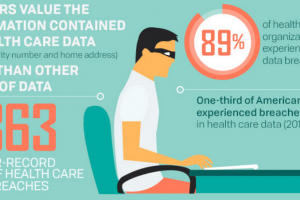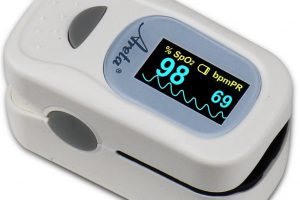Today, 96% of hospitals have converted to electronic health records (EHR). Since 83% of adults and 92 percent of children visit a doctor every year, health care systems manage an extraordinarily growing amount of data every year. While hospitals are beginning to apply big data techniques to predict individual outcomes like post-operative complications and diabetes risk, big data remains largely a buzzword.
To learn more, checkout the infographic below created by Regis College’s Online Masters of Health Administration program.
What Is Predictive Analytics?
Data in itself is not very useful if it is not utilized intelligently. Predictive analytics is used to process previous statistical data. The goal is to predict future trends and outcomes. Mathematical algorithms are used in this process. The purpose is to determine possible outcomes as accurately as possible. The technique has been used for several decades but it is only in recent years that it has gained momentum. Use of sophisticated computers and processors has made it possible to predict outcomes with a high degree of certainty.
Use of Predictive Analytics in Health Care
The health care industry has been a pioneer in using the most advanced technologies. It faces an endless number of challenges related to patient care, disease prevention and control, supply chain management, and hospital administration. All stakeholders in the industry now realize that better health care can be provided with intelligent use of data analytics. It can help prevent diseases in individuals, groups and communities that are at high risk. The power of historical data can be harnessed to intervene before a medical problem explodes on the scene and becomes difficult to control. It is useful in managing health care systems efficiently and economically.
Techniques Used in Predictive Analytics
The first step is to collect data throughout a medical process. The data must be stored properly in the correct format so that each element can be used in future programs. Data mining helps find patterns in a large database. This predictive modeling technique is used to create, test, and validate a model or scenario. It helps predict the likelihood of an outcome. Machine learning is a key part of this process. Now, artificial intelligence (AI) is being used to find trends that would normally go unnoticed.
Why Use Predictive Analytics?
The amount of data being generated in the health care industry has been growing exponentially. Without using advanced techniques and technologies, it is not possible to make sense of this data. More than half of US health care centers and organizations are using predictive analytics. Most hospitals and health care organizations have large plans to use tools and solutions related to this field. The volume of data collected and stored by the health care industry is only going to increase in the future. Without proper and effective use of this data, it is not possible to improve the health care sector. The medical industry as a whole needs to keep pace with other industries that are using innovative technologies to move ahead.
Benefits of Predictive Analytics
Predictive analytics is proving very useful for the health care industry. Doctors, hospitals, drug manufacturers, health care workers, and government agencies related to health care sectors are all taking advantage of big data analytics. It helps them predict future trends. They can make quick decisions at the right time. It is very effective in improving management of hospital inventory, personnel, and infrastructure. Hospital management can realize cost savings. There is improved transparency when all types of data can be accessed at the click of a button. Increased operational efficiencies make health care processes better for patients and health care workers. The money saved can be directed toward serious medical issues.
Future Trends
All stakeholders in the health care industry agree that predictive analytics is going to change the face of the industry for the better. They believe it is going to improve productivity. It will result in cost savings and operational efficiencies. Users of analytical solutions will perform better than their competitors. Most importantly, the quality of health care for patients will improve tremendously. People will face fewer health risks. It will benefit the family members of patients. There will be less pressure on health care workers.
Challenges
The health care field is going to face many challenges when trying to implement predictive analytics. It will need support services from other industries, especially from the information technology sector. There are various obstacles that hospitals will face in trying to make sense of the big data they collect. Often, there will be too much data, and some of it will not be in the proper format for analysis. Professionals working in the health care sector are largely trained only in medical subjects. It will be difficult for them to implement predictive analytics without proper guidance from professionals who have expertise in information technology. Many health care workers simply do not know about the subject of predictive analytics. It’s not on their radar. Also, there are regulatory hurdles to implementing data collection and analytics solutions. The hospital management team needs to find solutions to these and similar issues if it wants to improve efficiencies, increase productivity, achieve cost reductions, and provide affordable health care services.
Not Hard to Address Such Issues
It is not difficult to tackle the challenges of implementing predictive analytics in the health care environment. The first step is to hire staff that is familiar with analytical tools and technologies. The right amount of resources must be allocated to projects involving data collection, management, and analytics. The support of professionals having expertise in statistical and mathematical analytics is also important.
Most hospitals have now switched to EHR or Electronic Health Record systems. It has improved hospital operational efficiency, but it has also resulted in lots of data. The volume of this type of data is going to increase every year. Hospitals need to apply predictive analytic techniques not only to make this data useful, but to predict future outcomes. The insight will help prevent different types of diseases and ailments. Hospitals can manage more patients with fewer staff. Higher quality health care services can be provided to all patients.
To achieve these goals, it is necessary to develop proper standards for collecting, managing, and analyzing medical data. It is important to understand that prediction just for the sake of prediction is useless. The insights gained from data analytics must be converted into actions. It should help improve health care services, reduce treatment costs, lower risks of diseases, and help raise health care organizational efficiently.







 Your total news and information resource for all things Science, Technology, Engineering / Mathematics, Art, and Medicine / Health.
Your total news and information resource for all things Science, Technology, Engineering / Mathematics, Art, and Medicine / Health.
Leave a Comment